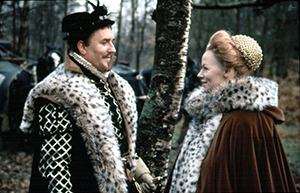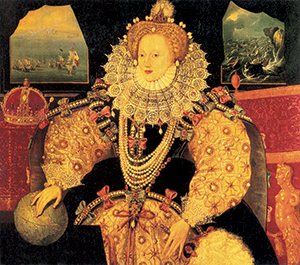Elizabeth R
Published in Issue 3 (May/June 2021), Reviews, Volume 29BBC Four, February/March 2021 (six episodes)
(first broadcast on BBC2 in 1971)
By Hiram Morgan

Above: Double crisis—Elizabeth (Glenda Jackson, above right) in one of the series’ rare outdoor scenes with old flame, Robert Dudley, earl of Leicester (Robert Hardy, above left), who died at the same time as the attempted Spanish invasion in the summer of 1588. Its engagement in the Channel and wreck on Ireland’s coast is depicted in the background of the famous ‘Armada painting’ (below). (Alamy, Royal Museums Greenwich, UK)
Glenda Jackson’s Elizabeth I is the quintessential portrayal of the sixteenth-century monarch, and what a performance! Jackson, aged 35 when the series was made in 1971, was equally convincing as the feisty red-haired teenage princess fending off the attentions of her stepfather, Thomas Seymour, and as the cantankerous wig-wearing queen in her sixties dealing with the tantrums of the Earl of Essex. It was also a timely intervention—a clarion call for the women’s liberation movement as well as an end-of-empire project picking nostalgically over its own shaky beginnings.
By today’s standards the dialogue is too dense and elaborate and, like many of the actors involved, owing more to the Royal Shakespeare Company than to the scriptwriters of Hollywood. It is set mainly at the English court, with clunky, theatrical interiors replete with high-backed chairs, wood panelling and tapestries. Recognisable features in Fontainebleau and the Escorial are recreated as backdrops for scenes at the French and Spanish courts. The occasional outdoor action has horses as the props of choice. A particular highlight is the fantastic dresses worn by the queen, which owe a lot to contemporary Elizabethan portraits. Interestingly, the series was preceded by a famous exhibition by Sir Roy Strong at the Tate Gallery in 1969. Funnily enough, this series is being reshown at the same time as Showtime’s The Tudors about Henry VIII. The latter, filmed in Ireland in 2007–10 with a big budget and the technological advantage of CGI, is far looser in dialogue and in adherence to the facts. More violent and prurient than the BBC’s masterpiece theatre, it nevertheless at least hints from time to time at the world of ideas.
 Both Elizabeth’s reign and her father’s (and, indeed, the whole era) were beset by the same problem—dynasticism—complicated further by the issue of religious division. Renaissance monarchies were more powerful than hitherto, with better administrations and stronger armies, but they were also family firms whose personal lives and marriage diplomacy caused unnecessary wars and havoc for the countries they inherited. Humanists like Erasmus with manuals such as The education of a Christian prince tried their best to advise kings, but the political strategies of Machiavelli were often the preferred alternative. The danger of having no heirs was obvious in a dynastic set-up, but the likelihood of a daughter succeeding was equally worrying. Liable to be overruled by her husband in a patriarchal age, the reign of a queen risked provoking internal wars if she was married to a local, whilst if she wed a foreigner the country might be drawn into his wars and lose its independence.
Both Elizabeth’s reign and her father’s (and, indeed, the whole era) were beset by the same problem—dynasticism—complicated further by the issue of religious division. Renaissance monarchies were more powerful than hitherto, with better administrations and stronger armies, but they were also family firms whose personal lives and marriage diplomacy caused unnecessary wars and havoc for the countries they inherited. Humanists like Erasmus with manuals such as The education of a Christian prince tried their best to advise kings, but the political strategies of Machiavelli were often the preferred alternative. The danger of having no heirs was obvious in a dynastic set-up, but the likelihood of a daughter succeeding was equally worrying. Liable to be overruled by her husband in a patriarchal age, the reign of a queen risked provoking internal wars if she was married to a local, whilst if she wed a foreigner the country might be drawn into his wars and lose its independence.
This was the problem that faced Henry VIII with Katherine of Aragon; having given him Princess Mary, she was unable to provide him with a son. When the pope could not give him an annulment, he had to break with Rome to marry Anne Boleyn. Their offspring was another girl, Elizabeth, and so it was not until he beheaded her and married Jane Seymour that he got a son, Edward. The young Elizabeth saw how Lady Jane Grey was manipulated in the attempt to put her on the throne after Edward, and then witnessed how England in the reign of Mary was in danger of being absorbed into the Habsburg empire, losing Calais, its remaining Continental possession, as a result of its alliance.
When Elizabeth did ascend the throne in 1558, privy councillors and parliamentarians urged her to marry and provide an heir. This was made more urgent by the existence of a rival Catholic claimant untainted by bastardry, Mary Queen of Scots, married to King Francis II of France. Yet Mary’s career was itself a counter-example pressing Elizabeth to stay single. Mary Stuart’s marriage to the French king risked Scotland’s becoming a province like Brittany and provoked a coup d’état by the Presbyterian Lords of the Congregation. When she returned as a widow in 1561, she married two local lords, Darnley and Bothwell, in succession, causing increasing political strife until she was deposed in favour of James VI, her infant son by the former.
In contrast, the English queen cleverly used her unmarried state to curry international favour, and Elizabeth R shows that. She took little interest in Prince Eric of Sweden and briefly toyed with Archduke Charles of Austria. It was the Duke of Alençon (later of Anjou) who was the really noteworthy foreign suitor. The young Valois prince, who came courting in person, is caricatured as louche and ineffectual. Entertaining him in an alliance made political sense as a way of encouraging France to oppose the threatening Spanish occupation of the Netherlands rather than England doing so itself. The queen liked Monsieur—she nicknamed him her ‘frog’—and he was her last chance for personal happiness. It quickly became evident that the increasingly Protestant nation would have no truck with marriage to a French Catholic. The very entertaining of the idea was deemed hypocritical after twenty years of ‘themselves alone’, and downright dangerous in the light of his family’s involvement in the St Bartholomew’s Day massacre of the Huguenots.
The same opponents who damned the Anjou marriage also martyred Mary Queen of Scots amid a fevered international situation spiralling out of control. Ever since she had sought refuge in England in 1568, the Scottish queen had been a focus of Catholic treason, with first the Rodolfi, then the Throckmorton and finally the Babington plot. Each time the English security apparatus moved her into closer confinement. In the end it did not wait for Mary to make the wrong move; rather, headed by Walsingham and a team of agents, it worked actively on her entrapment. Presented with evidence of malicious intent, Elizabeth was left with no choice but to try and execute her fellow monarch in 1587. With the now comic-sounding ‘Horrible Conspiracies’ as a title, this episode has the effect of absolving Elizabeth whilst damning her regime for the fate of Mary.
One of the most poignant aspects of Elizabeth R is its depiction of the queen’s relationship with Robert Dudley, Earl of Leicester. Marrying him would almost certainly have deepened factionalism and religious divisions in the court and country. He was one she loved. When his first wife, Amy Robsart, died after falling downstairs, he was free to marry, but the mysterious circumstances of the event caused too much talk. When he secretly married a lady-in-waiting, Elizabeth banished her from court. His sudden death overshadowed the Armada crisis. As land commander, he had organised her camp at Tilbury and was beside her when she gave her famous ‘heart and stomach of a king’ speech there. What is so effective is how drama here shows the private face of the public person, how his loss was far more important to her than the victory over Spain. Ireland should probably have featured in the Armada episode—as it was there that the Armada was destroyed by a ‘Protestant wind’ after being damaged in action in the English Channel.
Nevertheless, her mismanagement there eventually comes into view in the final episode, in which Patrick O’Connell played Hugh O’Neill, Earl of Tyrone. There are even a few lines of Irish where a horseman of the earl’s converses with an old woman tending a goat! The successful military tactics of the Irish are shown as a farcical mix of Robin Hood and Dan Breen. The script overreaches itself with Essex being effectively converted into a traitor at his famous one-to-one parley with the Irish leader at the Ford of Bellaclinthe on 7 September 1599. On the other hand, this was possibly fair game for the dramatist, as there is no actual record of what was said.
The same episode also has a clever double take on the nature of drama itself, when Essex and his friends have Shakespeare’s Richard II staged privately as they plot revolt. Off stage altogether, frequently though sometimes only obliquely referred to, is Elizabeth’s foreign successor, James VI, whom she stubbornly refuses to name as her heir. The queen’s death in March 1603—standing and then sitting bolt upright for hours—is also something to behold and apparently a matter of record. With such antics and such performances, it is no wonder that Elizabeth R provided the material for a delicious parody in Blackadder II’s rendering of the queen and her court in 1986. By the same token, the replaying of this series 50 years on may serve to reimprint such stereotypes that are surely in need of revaluation and updating in the light of the huge body of historical research undertaken in the interim.
Hiram Morgan is a Senior Lecturer in History at University College Cork.
















